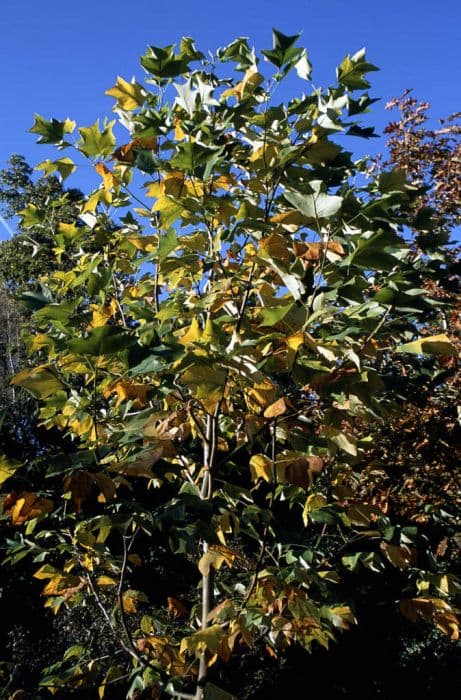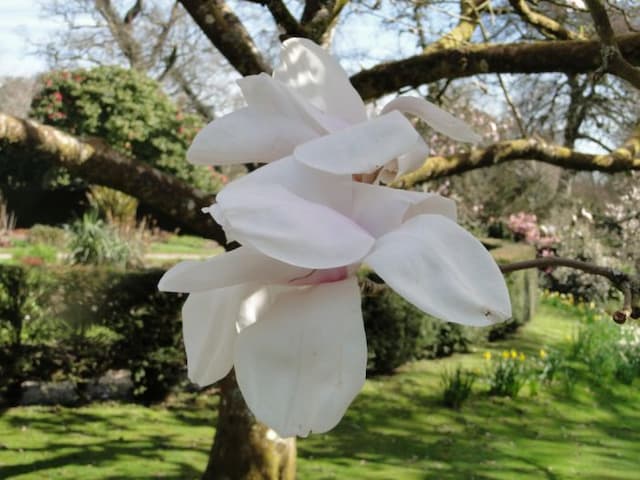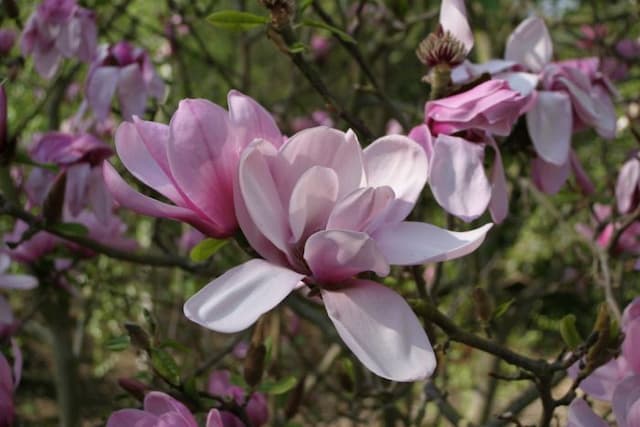Yellow Lantern Magnolia Magnolia 'Yellow Lantern'

ABOUT
The Magnolia 'Yellow Lantern' is known for its striking, tulip-shaped flowers that offer a beautiful display of yellow coloring. The petals are waxy and substantial, showcasing various shades of yellow that can range from pale buttery hues to deeper, sun-kissed tones, often with a slight gradation of color towards their bases. Inside, the flowers reveal a delicate interior that may have a subtle blush of pink or green near the base, which contains the reproductive parts of the flower. The plant's leaves are glossy and elongated, with a leathery texture and a lush green color that forms a striking contrast against the brightness of the blooms. The foliage tends to emerge after the flowers and can provide a dense and verdant backdrop through the growing season. The branching structure of 'Yellow Lantern' is robust, with a form that typically exhibits a pyramidal or oval shape, contributing to the plant's overall elegant and architectural appearance. The bark of this Magnolia is smooth and gray, creating a sophisticated look even in winter when the leaves have fallen. The blooms typically appear in the early to mid-spring, before the foliage, making this plant a herald of the warmer seasons. As the flowers mature, they may give way to seed pods that add additional interest later in the year. Overall, the Magnolia 'Yellow Lantern' is revered for its stunning floral display and graceful form, making it a highlight in any garden where it is featured.
About this plant
 Names
NamesFamily
Magnoliaceae
Synonyms
Yellow Lantern Magnolia
Common names
Magnolia 'Yellow Lantern'
 Toxicity
ToxicityTo humans
Magnolias, in general, are not known to be toxic to humans. The Yellow Lantern magnolia does not have notable toxicity, and accidental ingestion typically does not result in any symptoms of poisoning. However, as with any non-edible plant, eating large quantities of plant material could potentially cause stomach discomfort or an allergic reaction in sensitive individuals. It's always prudent to avoid eating plants that are not explicitly intended for human consumption.
To pets
Magnolias, including the Yellow Lantern magnolia, are largely considered non-toxic to pets. There are no significant toxic effects expected if pets, such as dogs or cats, ingest the leaves or flowers. Nonetheless, ingestion of large amounts of plant material may cause mild gastrointestinal upset, such as vomiting or diarrhea, due to the physical nature of the plant material rather than chemical toxicity. It’s always best to prevent pets from eating ornamental plants as a precaution.
 Characteristics
CharacteristicsLife cycle
Perennials
Foliage type
Deciduous
Color of leaves
Green
Flower color
Yellow
Height
25 feet (7.62 meters)
Spread
12 feet (3.66 meters)
Plant type
Tree
Hardiness zones
5
Native area
Southeastern United States
Benefits
 General Benefits
General Benefits- Aesthetic Appeal: The Magnolia 'Yellow Lantern' offers stunning yellow blooms that add a unique color and visual appeal to any garden or landscape.
- Year-Round Interest: With its attractive foliage, distinctive bark, and striking flowers, it provides visual interest in multiple seasons.
- Shade-Creating Canopy: The tree can grow to a considerable size, providing a natural shade canopy that can help cool surrounding environments.
- Habitat for Wildlife: It offers a habitat and food source for various species of birds and beneficial insects.
- Low Maintenance: Once established, it typically requires minimal care, making it a convenient choice for many gardeners.
- Privacy Screen: Its dense foliage makes it an effective plant for creating privacy screens or hedges in residential areas.
- Increased Property Value: Due to their beauty and grandeur, mature specimens can increase property values and curb appeal.
 Medical Properties
Medical Properties- This plant is not used for medical purposes.
 Air-purifying Qualities
Air-purifying QualitiesThis plant is not specifically known for air purifying qualities.
 Other Uses
Other Uses- Magnolia 'Yellow Lantern' petals can be used as a natural fabric dye, producing subtle yellow to green hues, depending on the mordant used.
- The wood of Yellow Lantern magnolia trees is sometimes used in fine woodworking or furniture-making due to its relative hardness and grain pattern.
- Extracts from the flowers can be used in perfumery to create unique floral scents for luxury fragrances.
- The fallen leaves of the Yellow Lantern can be collected and used as a natural mulch to enrich garden soil and suppress weeds.
- The bark of the Magnolia 'Yellow Lantern' can be used in small quantities to add to homemade potpourri mixes for a woody undertone.
- Pressed or dried Magnolia 'Yellow Lantern' flowers can be incorporated into decorative crafts such as resin jewelry or bookmark making.
- The seeds of the Yellow Lantern magnolia can be used to create botanical artworks or for educational purposes in seed dispersal studies.
- In photography, the distinct flowers of the 'Yellow Lantern' are often used as subjects for macro photography to explore natural patterns and color contrasts.
- During the holidays, the branches with buds can be cut and brought indoors to force early blooms for indoor decoration, adding a touch of early spring to winter settings.
- The large leaves and attractive blooms make the tree a good candidate for thematic landscaping designs that focus on yellow color schemes or Asian-inspired gardens.
Interesting Facts
 Feng Shui
Feng ShuiThe Magnolia is not used in Feng Shui practice.
 Zodiac Sign Compitability
Zodiac Sign CompitabilityThe Magnolia is not used in astrology practice.
 Plant Symbolism
Plant Symbolism- Nobility: Traditionally, magnolias are symbols of nobility and dignity due to their impressive appearance and long history, especially in the South of the United States where they have been cultivated for centuries.
- Perseverance: The magnolia's ability to withstand harsh conditions and still bloom beautifully represents perseverance and endurance.
- Feminine beauty: With its delicate, large petals, the magnolia is often associated with the softness and purity of feminine beauty.
- Peace and tranquility: The soothing color of the 'Yellow Lantern' variety and the serene appearance of the magnolia tree can evoke a sense of peace and tranquility.
- Inner strength: The sturdy nature of the magnolia tree, able to live for many years, symbolizes inner strength and stability.
- Welcoming: The magnolia is often planted in front of homes as a sign of hospitality and a welcoming gesture to guests.
 Water
WaterThe Magnolia 'Yellow Lantern', commonly known as Yellow Lantern Magnolia, needs consistent moisture, especially during its active growth in the spring and summer. It requires deep watering, ideally with about 2 gallons per week for young trees, and more for established trees, depending on weather conditions and soil drainage. In the absence of rain, water deeply once a week, thoroughly soaking the soil around the root zone. It's important not to overwater, as standing water can lead to root rot. During the winter, reduce watering frequency as the plant's growth slows down.
 Light
LightThe Yellow Lantern Magnolia thrives in full sun to partial shade conditions. A spot that provides at least 4 to 6 hours of direct sunlight with some afternoon shade is ideal to protect the leaves from too much heat. It can tolerate being in brighter spots but should be shielded from the harsh midday sun in very warm climates.
 Temperature
TemperatureThe Yellow Lantern Magnolia is hardy and can withstand temperatures as low as 0 to -10 degrees Fahrenheit in winter and enjoys the warmth of up to 90-100 degrees Fahrenheit in summer. The ideal temperature range for this Magnolia is between 60 and 75 degrees Fahrenheit. This plant has a moderate tolerance for temperature variations but should be protected from extreme cold snaps.
 Pruning
PruningPruning the Yellow Lantern Magnolia is primarily for shaping and removing any dead or broken branches. The best time to prune is soon after the plant has finished flowering in late spring or early summer to avoid cutting off next year's blooms. Light pruning and shaping can be done annually; however, extensive pruning should be undertaken less frequently, only when necessary for the health or aesthetics of the tree.
 Cleaning
CleaningAs needed
 Soil
SoilThe Yellow Lantern Magnolia requires well-draining, rich soil with a slightly acidic to neutral pH of around 5.5 to 7.0. A mix with loamy soil, compost, and peat moss will provide the nutrients and texture ideal for this plant's growth.
 Repotting
RepottingYellow Lantern Magnolias are slow-growers and should only be repotted when they outgrow their current container, usually every 3 to 5 years to refresh the soil and give the roots more space.
 Humidity & Misting
Humidity & MistingYellow Lantern Magnolias prefer average to high humidity levels; however, they are quite adaptable to various humidity conditions as long they are not in extremely dry environments.
 Suitable locations
Suitable locationsIndoor
Provide bright indirect light, ensure proper drainage.
Outdoor
Plant in full sun to part shade; shelter from harsh winds.
Hardiness zone
4-9 USDA
 Life cycle
Life cycleThe life of the Yellow Lantern Magnolia begins with germination from a seed, typically in spring when the soil temperatures are conducive to seedling growth. The plant then enters a juvenile phase, during which it develops its root system and initial foliage. As it matures, it progresses into the vegetative stage, focusing on growth and producing large, broad leaves. When it reaches maturity after a few years, the Yellow Lantern Magnolia enters the flowering stage, producing distinctive, large yellow flowers typically in early spring. Following pollination, the plant develops fruit, which is a cone-like aggregate of follicles containing seeds that are dispersed by wind or wildlife, completing its reproductive cycle. Throughout its life, the plant will repeat the flowering and fruiting cycle annually, while continuing to grow and expand in size, until it reaches the end of its lifespan, which can be several decades under ideal conditions.
 Propogation
PropogationPropogation time
Late Winter-Early Spring
The most popular method of propagating a Magnolia 'Yellow Lantern' is through semi-hardwood cuttings. This typically takes place in late summer after the current year's growth has begun to harden. Cuttings about 6 inches (15 centimeters) long are taken from healthy branches, with at least two sets of leaves at the top. The bottom end of the cutting is dipped in rooting hormone to encourage root growth and then planted in a well-draining potting mix. The pot is kept moist and in a warm place with indirect sunlight until roots develop, which can take several weeks. Once rooted, the new magnolia can be transplanted to a more permanent location outdoors.









![Magnolia [Felix Jury]](/_next/image?url=https%3A%2F%2Fplants-admin.emdemapps.com%2Fimages%2Fplants%2F%2Fimages%2F604b61a0b23b7.png&w=640&q=75)